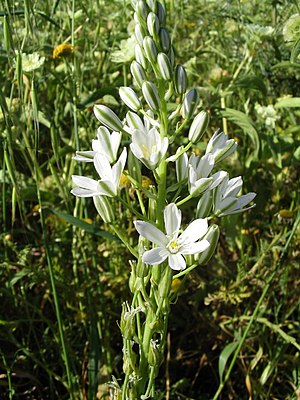Narbonne Milky Star
| Narbonne Milky Star | ||||||||||||
|---|---|---|---|---|---|---|---|---|---|---|---|---|

Narbonne Milky Star ( Ornithogalum narbonense ) |
||||||||||||
| Systematics | ||||||||||||
|
||||||||||||
| Scientific name | ||||||||||||
| Ornithogalum narbonense | ||||||||||||
| L. |
The Narbonne-Star of Bethlehem ( Ornithogalum narbonense ) is a plant from the family of asparagus plants (Asparagaceae).
description
The Narbonne Milky Star is a perennial , herbaceous bulb plant that usually reaches heights of 40 to 60 (80) centimeters. The leaves measure 20 to 40 × 0.6 to 1.1 centimeters and are usually dried up during flowering. The inflorescence is a 25 to 75-flowered, elongated raceme . The flowers are up to 5 centimeters in diameter, upright and do not smell. The bracts tower above the flower buds. The lower flower stalks are about 1.5 inches long. The cover sheets are slightly shorter. The petals are milky white inside, outside they have a narrow, tongue-shaped and uniform green stripe. They are 11 to 14 millimeters tall and the edges are rarely rolled up after flowering. The ovary each compartment having 5 to 7 ovules and is green, ovate, 2.5 to 5 millimeters long and shorter than the white and to the bottom thread-like stylus. The surface of the seeds is pigmented, granular-papillary.
The flowering period extends from April to July.
The Narbonne milk star is hexaploid with a chromosome number of 2n = 54 (there are different counts between 2n = 49 to 61). The counts of 2n = 14, 16, 18, 22, 24, 36 and 46 from Turkey are based on confusion with other species.
Occurrence
The Narbonne Milky Star occurs in the Mediterranean and the Canary Islands. There is a karyologically confirmed find from Turkey , almost all of the information relates to other species. The same goes for Armenia . Information from north-west Iran is karyologically unconfirmed.
It colonizes semi-arid grasslands , fields, fallow land and ruderal sites. In Crete the occurrences reach up to 1150 meters above sea level.
use
The Narbonne Milky Star is rarely used as an ornamental plant for heather and natural gardens.
literature
- Ralf Jahn, Peter Schönfelder: Excursion flora for Crete . With contributions by Alfred Mayer and Martin Scheuerer. Eugen Ulmer, Stuttgart (Hohenheim) 1995, ISBN 3-8001-3478-0 , p. 354 .
- Eckehart J. Jäger, Friedrich Ebel, Peter Hanelt, Gerd K. Müller (eds.): Excursion flora from Germany . Founded by Werner Rothmaler. tape 5 : Herbaceous ornamental and useful plants . Springer, Spektrum Akademischer Verlag, Berlin / Heidelberg 2008, ISBN 978-3-8274-0918-8 , pp. 743 .
Individual evidence
- ↑ Helmut Wittmann: Contribution to the systematics of the Ornithogalum species with elongated racemose inflorescence. In: Stapfia. Volume 13, Linz, pp. 31-42, PDF on ZOBODAT
- ↑ a b c d e Franz Speta : Contribution to the knowledge of the Loncomelos narbonensis relationship (Hyacinthaceae-Ornithogaloideae). In: Negotiations of the Zoological-Botanical Society in Austria. Volume 147, 2010, pp. 125-157 (PDF file) .
- ↑ Margaret AT Johnson, PE Brandham: New chromosome numbers in petaloid monocotyledons and in other miscellaneous angiosperms. In: Kew Bulletin. Vol. 52, No. 1, 1997, pp. 121-138, JSTOR 4117845 .
- ↑ Ornithogalum narbonense , chromosome number at Tropicos.org. Missouri Botanical Garden, St. Louis
- ↑ Franz Speta: A remarkable, new Loncomelos species from NE Turkey: L. erichpaschei Speta spec. nova (Hyacinthaceae-Ornithogaloideae). In: Phyton (horn). Volume 51, No. 1, pp. 152-160.